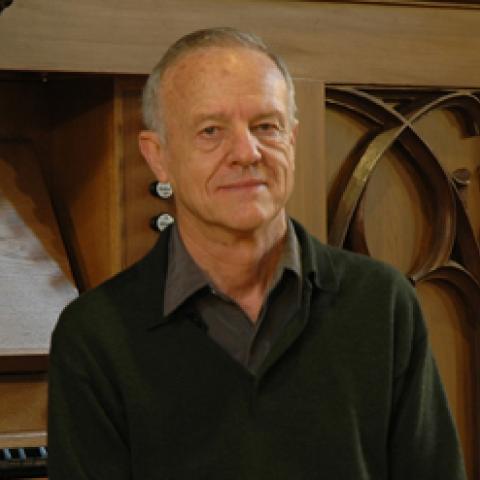
Nunc Dimittis
Alexander Shaw Mitchell, Jr., 76, of Danville, Virginia, died December 4 in Greensboro, North Carolina. Born January 8, 1940, in Shelter Island, New York, he began piano study at the age of four with his grandmothers, both church musicians, becoming a church musician by the age of thirteen. He married Henrietta “Hank” Schoolcraft Sherman on July 15, 1959, in Shelter Island.
Mitchell first studied elementary education in college, but left after the first year to move to Utica, New York, where he studied music at the Utica Conservatory of Music and was the organist and choirmaster at Calvary Episcopal Church, Utica, teaching piano and organ privately. After a decade in Utica he became the organist and choirmaster at St. Luke’s Episcopal Church in East Hampton, New York.
Alexander and Hank moved to Europe where he studied music in Italy, Germany, and England. In England, he studied organ and choral conducting at the Royal School of Church Music and eventually received his degree in music at the Royal School of Music in Manchester. He then settled in Cornwall where he served as organist and choirmaster of the local parish church. Returning to the United States in 1981, he served as organist and choirmaster at churches in New Bern, North Carolina, and in Eastville, Virginia. He moved to Danville in 1988, serving several local churches before settling at the Episcopal Church of the Epiphany where he was organist and choirmaster for 15 years before retiring in 2010. His retirement was short-lived as he was called to serve First Presbyterian Church in Danville as director of music for several years until his health failed.
Alexander Mitchell is survived by one brother, Ronald Mitchell, and family of Shelter Island, one step-grandson, Douglas Charles Hovey, and two step great-grandchildren.
David Rumsey, 77, Australian organist, pedagogue, researcher, composer, and consultant, died February 12, 2017, in Basel, Switzerland. Born in Sydney, Australia, March 30, 1939, he was a major figure in the development of Australian organ playing, repertoire, recording, and building since the mid 1960s. He studied organ with Norman Johnston at the Sydney Conservatorium of Music, graduating as student of the year in 1963, after which he went to Europe to study with Marie-Claire Alain in Paris, France, and Anton Heiller at the Vienna Akademie, where he graduated in 1966. He returned to Australia in 1966 together with fellow Heiller student, Christa Brosch, whom he married.
Moving from Adelaide to Sydney in 1969, Rumsey established the organ and church music programs at the Sydney Conservatorium of Music and led the department for the following thirty years. He organized extensive European organ tours throughout his tenure. His repertoire was broad, and included early music and contemporary Australian organ music. He was organist for the Sydney Symphony Orchestra throughout this period. In 1998, he wrote, produced, acted, and performed in a 14-hour musical and dramatic spectacle on the life of
J. S. Bach, with actors in period costume from the National Institute of Dramatic Art (AUS), and musicians playing period instruments.
That same year, he married Elizabeth Jones, and they moved to Basel, Switzerland, in 1999. He continued his commitment to organ research, particularly in his collaboration with Kimberly Marshall on a lexicographical collection of articles about the organ while pursuing his playing and lecturing career. He was the organist of the Catholic church in Laufen, near Basel, and in 2010, in collaboration the Dutch organbuilder Winold van der Putten, designed and commissioned the building of a Gothic organ. A significant emphasis over the recent years has been his collaboration with Daniel Debrunner on the restoration, curation, and promotion of the 1913 Welte Philharmonic Organ (originally destined for HMHS Britannica, now housed in the Swiss national museum of automated musical instruments in Seewen) and the preservation and documentation of the collection of rolls recorded on the instrument by eminent organist/composers of the early 20th century.
Among his articles published in The Diapason are “The Origins of Seewen’s Welte-Philharmonie” (February 2008), “Welte’s Philharmonie roll recordings 1910–1928: My afternoons with Eugène Gigout” (February 2011), and “In Search of the Secrets of Medieval Organs: The European Summer of 2012—A Report and Some Reflections” (May 2013).
David Rumsey is survived by his wife, Liz, two daughters, Stella and Marie, and four granddaughters.



